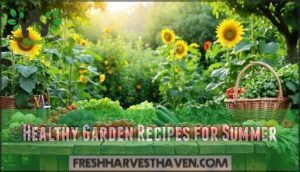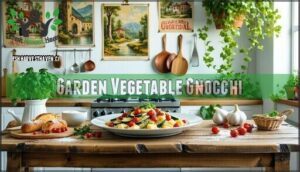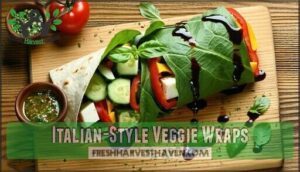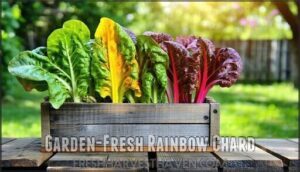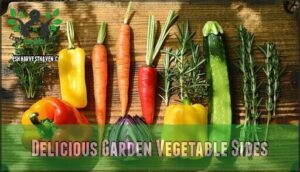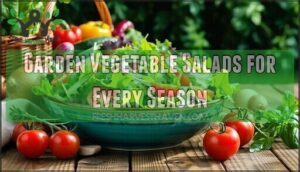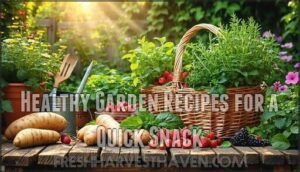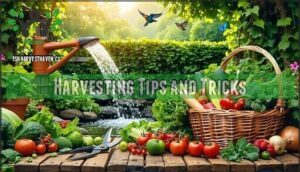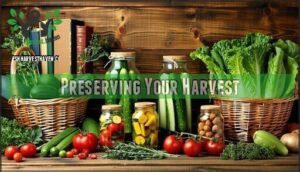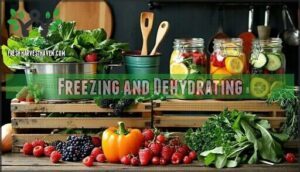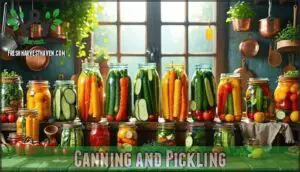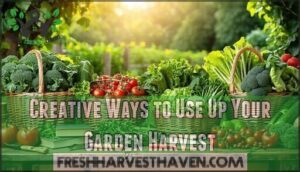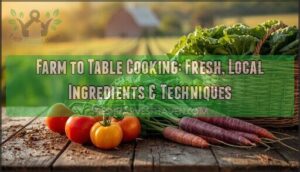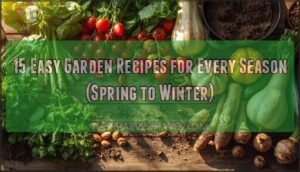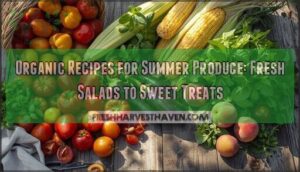This site is supported by our readers. We may earn a commission, at no cost to you, if you purchase through links.
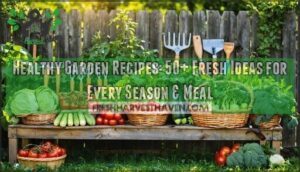 You can transform your garden harvest into nutrient-packed meals that pack 40% more vitamins than store-bought produce. Healthy garden recipes like stuffed poblano peppers, grilled zucchini skewers, and rainbow chard dishes turn your backyard bounty into delicious dinners.
You can transform your garden harvest into nutrient-packed meals that pack 40% more vitamins than store-bought produce. Healthy garden recipes like stuffed poblano peppers, grilled zucchini skewers, and rainbow chard dishes turn your backyard bounty into delicious dinners.
Fresh herbs, tomatoes, and leafy greens create flavorful combinations that taste better and cost less than grocery alternatives. Don’t toss those carrot tops or herb stems – they make excellent pesto and compound butters.
Your homegrown vegetables retain peak nutrients when harvested at the right time, giving you maximum health benefits in every bite.
Table Of Contents
- Key Takeaways
- Benefits of Healthy Garden Recipes
- Healthy Garden Recipes for Summer
- Garden Vegetable Mains for a Healthy Diet
- Delicious Garden Vegetable Sides
- Healthy Garden Vegetable Soups
- Garden Vegetable Salads for Every Season
- Healthy Garden Recipes for a Quick Snack
- Garden Vegetable Drinks and Smoothies
- Harvesting and Preserving Your Garden Produce
- Creative Ways to Use Up Your Garden Harvest
- Frequently Asked Questions (FAQs)
- How do you make a healthy vegetable salad?
- What are some summer vegetable recipes?
- What is a healthy garden salad?
- How do I use up vegetables from my garden?
- What can I eat with a garden salad?
- How do you make a garden salad?
- What to eat in a garden?
- What do you put in a garden salad?
- How do you prepare a garden to table meal?
- What vegetables can you eat in the garden?
- Conclusion
Key Takeaways
- You’ll get 40% more vitamins from homegrown vegetables compared to store-bought produce when you harvest at peak ripeness and use them within 24 hours.
- Your garden saves money and helps the environment – producing $677 worth of vegetables annually while cutting food miles and storing up to 1 ton of CO2 per acre.
- You can preserve your harvest year-round through freezing, dehydrating, pickling, and canning to maintain nutrients and reduce food waste during peak growing seasons.
- Simple cooking methods like grilling, roasting, and sautéing transform fresh garden vegetables into nutrient-dense meals without complicated recipes or techniques.
Benefits of Healthy Garden Recipes
When you grow your own vegetables and cook with them, you’re getting up to 40% more vitamins and minerals compared to store-bought produce.
Home-grown vegetables deliver up to 40% more vitamins and minerals than their store-bought counterparts
You’ll also cut your carbon footprint while creating meals that taste better and cost less than anything from the grocery store.
Nutritional Value of Homegrown Produce
Through careful cultivation, your homegrown vegetables deliver exceptional nutrition that store-bought produce simply can’t match. When you harvest at peak ripeness, you’re capturing vitamin retention levels up to 100% higher than grocery store options. Fresh ingredients from your garden contain elevated mineral content, including magnesium, iron, and calcium that’s often 60-125% more abundant than conventional varieties.
Your garden vegetables provide organic benefits without synthetic pesticides, creating cleaner, safer nutritious meals for your family. This outstanding nutrition reaches its highest levels within 24 hours of harvesting, giving you maximum antioxidant compounds and essential vitamins. To enhance the benefits, consider focusing on nutrient-rich vegetables in your garden.
Here’s what makes your healthy garden recipes truly special:
- Fresh-picked vegetables retain water-soluble vitamins that deteriorate during transport
- Homegrown vegetables contain up to 69% higher antioxidant concentrations
- Garden soil rich in compost produces more nutrient-dense crops
- You control harvest timing for ideal flavor and nutritional value
Environmental Impact of Home Gardening
Beyond feeding your family, home gardening transforms you into an environmental hero. Your garden eliminates transportation emissions while creating powerful carbon sequestration—storing up to 1 ton of CO2 per acre annually through improved soil health.
You’ll achieve significant water conservation, using 30-50% less water than traditional lawns through efficient irrigation. Your homegrown vegetables eliminate pesticide exposure while supporting biodiversity—creating habitats where pollinator populations thrive by 60-70%. One key method for this is to improve soil water retention by adding compost.
Your garden harvest also addresses food waste—no spoiled produce from long transport chains. Each tomato represents measurable reduced emissions and genuine garden food security. You’re not just growing dinner; you’re cultivating a healthier planet through simple home gardening practices.
Cost-Effectiveness of Growing Your Own Food
Beyond the environmental benefits, your garden becomes a powerful money-saving tool. Home vegetable gardens generate an average of $677 worth of produce annually while costing just $238 to establish. That’s an impressive return on labor that keeps giving year after year.
- Seed cost savings multiply when you save seeds from your best plants
- Organic vs. conventional pricing favors homegrown vegetables by eliminating retail markups
- Reduced grocery bills happen immediately once your garden vegetables start producing
- Long-term investment pays dividends through perennial crops and reusable infrastructure
- Garden food security protects against price fluctuations while you reduce food waste
Your healthy garden recipes practically pay for themselves.
Increased Food Security and Sustainability
Your garden harvest creates a reliable food source that strengthens local food systems. Homegrown vegetables reduce food miles while sustainable gardening practices build community resilience. You’ll develop seed saving strategies and reduce food waste through harvest-only-what-you-need approaches. Community garden benefits extend beyond individual households, creating shared knowledge and nutritious meals for neighbors.
| Garden Security Benefit | Impact | Timeline |
|---|---|---|
| Reduced food miles | Lower carbon footprint | Immediate |
| Seed saving strategies | Cost reduction | Annual |
| Community garden benefits | Shared resources | Ongoing |
Healthy Garden Recipes for Summer
Summer’s garden bounty gives you fresh ingredients that pack maximum nutrition and flavor into every bite.
You’ll create vibrant salads and light meals using peak-season tomatoes, cucumbers, and leafy greens that contain up to 40% more vitamins than store-bought produce.
Crunchy Lemon-Pesto Garden Salad
This vibrant garden salad combines fresh pesto with bright lemon juice for an unbeatable dressing. The lemon benefits include vitamin C and enhanced nutrient absorption, while the salad crunch comes from crisp lettuce, cherry tomatoes, and cucumbers. This summer salad delivers an impressive nutritional profile with minimal calories.
Three key preparation tips:
- Make your own pesto variations using spinach or arugula
- Harvest salad ingredients in the morning for maximum freshness
- Toss dressing just before serving to maintain crispness
These healthy garden recipes work perfectly as light lunches or dinner sides. Serving suggestions include adding grilled protein or enjoying with crusty bread for a complete meal.
Strawberry Kale Salad
Your strawberry kale salad combines sweet and savory perfectly. This healthy garden favorite packs serious kale benefits with vibrant strawberry pairings that make salad nutrition delicious.
Here’s your simple recipe:
- Massage fresh kale leaves until tender
- Add sliced strawberries from your garden
- Sprinkle toasted almonds for crunch
- Top with bacon bits for contrast
Choose light dressing options like honey-lemon vinaigrette. Seasonal variations work year-round with frozen strawberries too.
Sesame-Ginger Cucumber Salad
This cucumber salad delivers a flavor punch that’ll wake up your taste buds. Thinly slice garden fresh cucumber varieties and toss with sesame oil’s nutty goodness. Fresh grated ginger adds a fresh and mildly spicy bite, while sesame benefits include healthy fats. This Asian cuisine staple transforms simple salad ingredients into something special.
Cucumber Tomato Salad
Nothing beats the simple pleasure of fresh cucumber tomato salad on a hot summer day. This garden salad combines crisp cucumber with juicy tomatoes for the perfect summer side dish.
Sweetness Balance comes from letting salt draw out the tomatoes’ natural juices. Serving Suggestions include pairing with grilled fish or serving alongside barbecue favorites. The key lies in using peak-season produce from your garden when flavors reach their absolute best.
- Vinegar Variations: Rice vinegar creates a mild tang, while white wine vinegar adds brightness to your cucumber and tomato combo.
- Herb Pairings: Fresh oregano and parsley complement both vegetables beautifully in summer salads.
- Cheese Additions: Goat cheese or ricotta salata transforms this simple salad into a satisfying main course.
Summertime Tomato Salad
Four tomato varieties create the perfect summer tomato salad. Mix heirlooms, cherries, and beefsteaks with sweet corn and fresh basil. Fresh herbs and seasonal pairings with mozzarella make these garden tomato recipes shine.
Try different salad dressings like balsamic or lemon vinaigrette. Recipe variations include adding cucumber or red onion for extra crunch in your summer salads.
Garden Vegetable Mains for a Healthy Diet
You’ll turn your garden bounty into satisfying main dishes that pack serious nutritional value.
These vegetable-centered meals prove you don’t need meat to create filling, protein-rich dinners that satisfy your whole family.
Stuffed Poblano Peppers
Your garden’s poblano peppers deserve center stage in these satisfying stuffed pepper creations. These thick-walled beauties transform into hearty, garden-fresh meals when filled with nutritious ingredients. Perfect for garden vegetable recipes, they offer endless possibilities:
- Pepper Roasting Tips: Char skins over an open flame for smoky depth
- Stuffing Variations: Combine quinoa, black beans, corn, and cheese
- Vegetarian Options: Use mushrooms and nuts for a protein-rich filling
- Spice Level: Remove seeds to control heat intensity
Serving Suggestions include pairing with cilantro rice.
Garden Vegetable Gnocchi
Fresh homemade gnocchi transforms your garden vegetables into authentic Italian cuisine. These pillowy potato dumplings pair beautifully with zucchini, cherry tomatoes, and fresh herbs straight from your garden.
This healthy pasta alternative offers excellent vegetarian options while maximizing your harvest’s nutritional value. The gnocchi recipe requires simple ingredients and cooking techniques that highlight each vegetable’s natural flavors.
You can intensify flavors by sautéing with olive oil and herbs. Toss with olive oil, garlic, and seasonal produce for satisfying garden vegetable recipes that bring Italy to your table.
Italian-Style Veggie Wraps
Italian-Style Veggie Wraps transform your garden vegetables into Mediterranean delights. You’ll layer fresh mozzarella options with crisp bell peppers, tomatoes, and cucumbers on spinach tortillas. Italian herbs like basil enhance flavor while pesto variations add richness.
Drizzle balsamic glaze for that authentic Mediterranean twist. These recipes showcase summer’s bounty perfectly. Pair with soup or salad for complete meals that satisfy.
Garden-Fresh Rainbow Chard
After wrapping up those Italian-inspired wraps, you’ll want to explore another colorful garden star. Rainbow chard delivers serious Chard Nutrition—packed with vitamins A, C, and K. Garden Cultivation couldn’t be simpler, and Rainbow Varieties offer stunning stems from bright yellow to deep red.
Cooking Methods transform these fresh garden leaves into something special. Sauté stems first, then add leaves with garlic and olive oil. The result? A vibrant chard recipe that’s both nutritious and beautiful.
Here’s why you’ll love growing this rainbow gem:
- Harvest baby leaves in just 30 days
- Stems taste like mild celery with earthy sweetness
- One plant keeps producing for months
- Perfect Flavor Pairings include lemon, pine nuts, and parmesan
These garden vegetables shine in healthy cooking, making fresh rainbow chard perfect for any seasonal dish you’re craving.
Garden Pork Stir-Fry
With tender pork and crisp garden vegetables, this stirfry recipe creates a perfect balance of protein and nutrients. Your homegrown produce transforms into a satisfying meal that’s ready in minutes.
Pork preparation starts with choosing lean cuts like tenderloin or shoulder. Slice against the grain for maximum tenderness. A simple marinade of soy sauce, ginger, and garlic enhances flavor while keeping things healthy.
Vegetable pairings work best when you cut everything uniformly. This ensures even cooking and preserves those valuable nutrients your garden worked so hard to create.
Stir-fry techniques require high heat and constant movement. Here’s what makes the difference:
- Cook pork first, then set aside to avoid overcooking
- Add harder vegetables like carrots before softer ones like zucchini
- Keep cooking time under 5 minutes for maximum nutritional balance
Sauce variations can include honey-soy glazes or sesame-based options. Serve over brown rice for a complete, garden-fresh meal.
Delicious Garden Vegetable Sides
You’ll transform your garden’s fresh vegetables into perfect side dishes that complement any meal.
These simple recipes use seasonal produce at its peak, providing maximum nutrition and flavor while taking just minutes to prepare.
Grilled Zucchini
You can turn any summer garden harvest into something special with grilled zucchini. Slice your zucchini lengthwise, about half-inch thick. Zucchini marinades with olive oil, herbs, and garlic work wonders. Grill 3-4 minutes per side until tender with nice char marks.
These zucchini recipes showcase simple grilling techniques that lock in flavor. The nutritional benefits include vitamin C and fiber with only 73 calories per serving. Recipe variations include adding balsamic or lemon zest.
Serving suggestions range from standalone sides to chopped additions for pasta. These healthy garden recipes prove summer recipes don’t need complexity. Explore related product options for enhanced grilling.
Minty Peas and Onions
Garden fresh peas and onions create magic when you add mint to the mix. This simple side dish showcases how mint pairing elevates everyday vegetables into something memorable. You can use different pea varieties—sugar snap peas add crunch, while English garden peas bring classic sweetness.
Sweet onions caramelize beautifully, creating natural sugar that balances mint’s brightness. Fresh mint benefits include digestive support and antioxidants.
Try creamy variations by adding a splash of cream or butter. The combination works perfectly with spring recipes, letting your garden ingredients shine. This healthy side proves simple cooking techniques create impressive results.
Spring Asparagus
Fresh spring asparagus spears bring exceptional flavor and nutrition to your healthy garden recipes. Growing asparagus takes patience since it’s perennial, but asparagus varieties like Mary Washington and Jersey Knight reward you for years.
Asparagus nutrition packs folate, vitamin K, and fiber into every tender bite. Simple cooking methods work best – roast at 425°F for 12-15 minutes with olive oil and garlic, or quickly sauté with lemon zest.
For asparagus storage, wrap spears in damp paper towels and refrigerate upright. Your garden’s spring harvest delivers peak freshness that store-bought simply can’t match. Understanding seasonal vegetable benefits is key to maximizing the nutritional value of your asparagus.
Parmesan-Roasted Broccoli
After mastering spring asparagus, you’ll discover that Parmesan-Roasted Broccoli elevates this nutritious vegetable into a crispy, golden masterpiece. Roasting techniques reveal broccoli’s natural sweetness while preserving essential broccoli nutrition like vitamin C and fiber.
Here’s your simple roadmap to perfect results:
- Cut fresh broccoli into uniform florets for even cooking
- Toss with olive oil, garlic, and salt before adding grated Parmesan
- Roast at 425°F until edges turn golden and crispy
- Finish with lemon zest or red pepper flakes for extra flavor
Broccoli benefits shine through this cooking method, maintaining nutrients while creating irresistible texture.
Smart vegetable pairings include serving alongside grilled chicken or mixing into pasta dishes. This garden fresh meals approach transforms humble garden vegetables into restaurant-quality sides. Your healthy garden recipes collection needs this winner – it’s proof that garden vegetable dishes can steal the spotlight at any dinner table.
So-Sweet Squash Pickles
Your garden’s overflowing with squash varieties like zucchini and yellow squash? Time to master pickling methods that turn surplus into treasure.
Sweet brine combines vinegar, sugar, and spices, creating the perfect balance for sosweet squash pickles. These canning tips guarantee crisp texture: slice thin, salt briefly, then rinse.
Garden harvest abundance becomes pantry gold with these healthy garden recipes. Your pickles stay fresh for months, ready to brighten winter meals with summer’s sweetness.
Healthy Garden Vegetable Soups
You’ll transform your garden’s fresh vegetables into nourishing soups that warm you from the inside out.
These recipes make the most of seasonal produce, turning simple ingredients like tomatoes, herbs, and leafy greens into satisfying meals packed with vitamins and minerals.
Dill Chicken Soup
Moving from simple sides to hearty soups, comfort food becomes the main attraction with this nourishing bowl. When cold weather calls for something warm and healing, dill chicken soup answers with garden-fresh flavor that beats any canned version.
You’ll love how fresh dill transforms ordinary chicken broth into something special. The herb’s bright, tangy notes complement tender chicken perfectly, while your homegrown vegetables add natural sweetness and nutrients. This soup nutrition powerhouse delivers protein, vitamins, and minerals in every spoonful.
Here’s what makes this herbal remedy so satisfying:
- Aromatic steam rising from golden chicken broth infused with feathery dill fronds
- Tender chicken pieces floating alongside colorful garden vegetables like carrots and celery
- Rich, savory taste that warms you from the inside out on chilly evenings
These healthy recipes work best when you harvest dill at its peak. The dill flavor stays strongest when added during the last few minutes of cooking, preserving those essential oils that make this soup truly memorable.
Shrimp Gazpacho
Beating summer heat becomes easy with this cooling shrimp gazpacho that transforms your garden’s tomato bounty into Spanish-inspired elegance. You’ll love how this no-cook cold soup delivers seafood nutrition while keeping your kitchen cool during sweltering afternoons.
Fresh garden tomatoes provide the base, while plump shrimp adds protein that makes this more filling than traditional gazpacho soup. The combination creates perfect summer meals that satisfy without weighing you down.
- Smart prep tip: Chill all ingredients beforehand for maximum refreshment.
Serve this chilled masterpiece alongside crusty bread for texture contrast, or pair with summer salads for a complete feast.
Cod and Asparagus Bake
While gazpacho offers invigorating coolness, this baked cod brings comforting warmth to your table. You’ll create a protein-packed meal using fresh asparagus from your garden. Healthy baking at 400°F for 15-20 minutes transforms simple ingredients into seafood dishes that impress.
Asparagus tips: Choose firm, bright spears for best results. Fish recipes like this cod bake work perfectly with a garden recipes approach.
| Component | Prep Time | Cook Temp | Benefits |
|---|---|---|---|
| Cod fillets | 5 minutes | 400°F | Lean protein |
| Fresh asparagus | 3 minutes | 400°F | Vitamins K, C |
| Lemon herbs | 2 minutes | Same pan | Flavor boost |
| Complete meal | 10 minutes | One dish | Easy cleanup |
This healthy garden recipes approach delivers restaurant-quality results at home.
Garden Vegetable Broth
Your vegetable scraps don’t belong in the trash—they’re pure liquid gold waiting to happen. Transform carrot tops, onion skins, and celery leaves into rich garden vegetable broth that’ll boost your healthy garden recipes all year long.
- Instant Pot Vegetable Broth: Pressure cook vegetable scraps for 30 minutes, then strain for concentrated flavor.
- Garden Simmer Method: Slow-cook stems and peels for 2 hours to extract maximum broth nutrition.
- Broth Recipes Storage: Freeze in ice cube trays for convenient portions in future garden recipes.
Garden Vegetable Salads for Every Season
You can create fresh, vibrant salads using whatever’s growing in your garden right now, from crisp summer tomatoes to hearty winter greens.
These seasonal combinations let you pack maximum nutrients into every bowl while making the most of your harvest’s natural flavors.
Summer Salad by The Lake
Picture yourself enjoying lakefront picnics with this revitalizing summer salad creation. Mix garden-fresh lettuce, strawberries, and walnuts for the perfect garden salad base. These healthy garden recipes shine with seasonal flavors and summer greens.
| Ingredient | Garden Fresh Benefit |
|---|---|
| Crisp lettuce | Provides healthy hydrators |
| Ripe strawberries | Delivers seasonal flavors |
| Toasted walnuts | Adds satisfying crunch |
| Light vinaigrette | Enhances garden vegetable dishes |
Chill your bowls beforehand and pack them in insulated containers for perfect lakefront picnics.
Farmers Market Street Tacos
Your farmers market haul transforms into vibrant street tacos packed with market ingredients. These healthy garden recipes showcase farm fresh vegetables through creative taco fillings and fresh salsa.
- Layer grilled zucchini, peppers, and radishes in corn tortillas
- Add homemade fresh salsa using garden tomatoes and herbs
- Top with taco toppings like avocado, cilantro, and lime
This street food approach makes summer salads exciting while celebrating garden vegetable dishes.
Triple Tomato Flatbread
The Triple Tomato Flatbread transforms your garden’s tomato varieties into a stunning meal. You’ll layer sun-dried tomatoes as your flavorful base, add meaty plum tomatoes for substance, then top with sweet cherry tomatoes for color. These flatbread recipes shine with fresh herb combinations like basil and oregano. Simple baking techniques create crispy crusts that support garden-fresh ingredients beautifully. Your healthy garden recipes get elevated when you combine different tomato recipes on one delicious canvas.
Tomato Type Flavor Profile Best Use
Caprese Salad Kabobs
These Italian-inspired skewers bring restaurant elegance to your backyard. Thread fresh mozzarella balls, heirloom tomatoes, and basil leaves onto wooden picks for perfect appetizers.
Your garden’s cherry tomatoes pair beautifully with creamy cheese and aromatic herbs. Drizzle finished grilled skewers with balsamic glaze for that authentic caprese flavor. Each bite delivers the essence of summer in one colorful package.
- Use metal skewers for grilling or wooden picks for fresh salad presentations.
Easy Seafood Salad
In the context of creating delicious ocean delights, you’ll find that seafood nutrition combines perfectly with garden-fresh vegetables. Packed with protein and healthy omega-3 fatty acids, seafood is both delicious and good for you. Mix your fresh catch with crisp garden cucumbers, cherry tomatoes, and colorful vegetables for an unbeatable salad that’s ready in minutes. Choosing sustainable fishing options promotes the ecological balance of marine life while minimizing environmental impact.
Choose lean proteins – Shrimp, crab, or scallops work perfectly
- Add garden vegetables – Cucumbers, tomatoes, and leafy greens provide crunch
- Create simple salad dressings – Lemon juice and herbs complement natural flavors
- Mix and serve – No cooking required, just combine and enjoy immediately
These adaptable salads transform everyday ingredients into something special.
Healthy Garden Recipes for a Quick Snack
When you’re craving something tasty between meals, your garden provides the perfect ingredients for quick, nutritious snacks. Fresh produce like sweet potatoes, berries, and herbs transform into satisfying treats that fuel your body with vitamins and natural energy.
Lemon-Apricot Fruit Pops
When fresh apricots from your garden meet bright lemon zest, magic happens. These fruit pop recipes transform your garden harvest into cool summer treats.
Simply puree ripe apricots, add fresh lemon juice, and freeze in molds. Apricot benefits include vitamin A and fiber, making these frozen desserts both delicious and nutritious. Your healthy garden recipes never tasted so good.
Chia Seed Protein Bites
Why settle for store-bought snacks when you can whip up these nutritious energy balls in minutes? Chia seed protein bites deliver exceptional seed nutrition and protein sources in every bite. These healthy bites require no baking, just mix and chill.
Perfect chia benefits include:
- Omega-3 fatty acids for brain health
- Fiber content supporting digestion
- Plant-based protein for sustained energy
- Calcium and magnesium for strong bones
- Antioxidants fighting inflammation
Your healthy garden recipes get an upgrade with these portable energy balls that fuel busy days naturally.
Coconut Milk Strawberry-Banana Pops
These coconut milk strawberry-banana pops transform your garden’s ripest strawberries and bananas into creamy frozen treats that’ll make summer desserts unforgettable. You’ll love how the rich coconut milk creates a dairy-free base that rivals any store-bought option. These healthy snacks prove that fruit popsicles can satisfy sweet cravings while keeping things simple and nutritious.
- Garden-fresh ingredients: Use ripe strawberries straight from your patch for maximum flavor
- Creamy texture: Coconut milk provides natural richness without dairy
- Customizable flavors: Blend in other fruits from your garden harvest
- Kid-approved: Simple, healthy snacks that beat store-bought options
Perfect for garden-to-table meals, these coconut recipes deliver summer refreshment that’s both wholesome and delicious.
Air-Fryer Sweet Potato Fries
Air-fryer sweet potato fries turn your garden’s sweet potato harvest into crispy excellence. These healthy snacks pack sweet potato nutrition while using minimal oil—a major air fryer benefit. Slice fresh sweet potatoes, season lightly, then air fry for golden, crispy fries. This healthy frying method creates irresistible vegetable snacks from your summer harvest bounty.
Roasted Beetroot and Garlic Hummus
After sweet potato fries, this vibrant beetroot and garlic hummus brings color and nutrition to your snacking routine. You’ll love how roasted vegetables transform ordinary hummus recipes into something remarkable.
Beetroot benefits include folate, fiber, and nitrates that support heart health. When combined with roasted garlic health properties, this garden recipe creates a powerhouse dip that’s both delicious and nutritious.
- Wrap fresh beetroots in foil and roast at 400°F for 45 minutes
- Roast garlic cloves alongside until golden and soft
- Blend everything with tahini, lemon juice, and olive oil
- Season generously with salt and cumin
- Serve immediately with garden vegetables or pita chips
This summer harvest creation showcases how simple dip variations can enhance your healthy garden recipes into stunning appetizers.
Garden Vegetable Drinks and Smoothies
You’ll transform fresh garden produce into nutritious drinks that pack vitamins and minerals into every sip.
These smoothies and beverages use seasonal ingredients like leafy greens, berries, and herbs to create invigorating options that support your daily nutrition goals.
Nectarine Smoothies
With summer’s golden nectarines ripening in your garden, you’re sitting on a treasure trove of smoothie potential. These nectarine benefits shine through every sip—vitamin A for healthy skin, vitamin C for immunity, and natural sugars that make your taste buds dance. Smoothie variations become endless when you master blending techniques that preserve the fruit’s creamy texture.
Start with frozen nectarine chunks for thickness, then add liquid gradually. This sweetness balance prevents watery disappointments while maximizing flavor.
Your recipe customization options include:
- Greek yogurt for protein that keeps you full
- Fresh mint leaves for a cooling summer twist
- Spinach for hidden nutrients without taste changes
- Coconut water for natural electrolyte replacement
- Chia seeds for omega-3s and fiber boost
These healthy garden recipes prove that nutritious meals don’t need complicated ingredients. Your summer harvest provides fresh ingredients that beat any store-bought version, creating garden recipes that nourish your body naturally.
Blueberry Banana Smoothie
Perfect fruit combinations start with this blueberry banana smoothie that’s packed with blueberry nutrition and banana benefits. You’ll get potassium, fiber, and antioxidants in every sip.
Add smoothie boosters like chia seeds or protein powder for extra nutrition. These summer refreshers showcase garden fresh ingredients perfectly.
Blend frozen fruit for thickness, fresh spinach for greens. These healthy garden recipes prove nutritious meals from your summer harvest taste wonderful.
Lime Coconut Smoothie Bowl
While blueberry banana smoothies offer comfort, your lime coconut smoothie bowl brings tropical paradise to breakfast. This creamy creation combines coconut milk with fresh lime zest for a revitalizing start that tastes like healthy desserts.
Make yours special with these tropical fruits and toppings:
- Fresh kiwi slices and mango chunks for natural sweetness
- Toasted coconut flakes or crunchy granola for texture
- Chia seeds packed with omega-3s and fiber
- Sliced almonds or pistachios for a protein boost
- Fresh herbs like mint from your garden harvest
This smoothie bowl proves healthy garden recipes don’t always need vegetables. Sometimes the best summer salads come in liquid form, using garden-fresh ingredients and coconut milk to create something that nourishes your body while satisfying your sweet tooth.
Kale Smoothie
Your kale smoothie transforms bitter greens into a nutritional powerhouse that actually tastes spectacular. Garden-fresh kale delivers iron, vitamins, and antioxidants while maintaining surprising sweetness through smart ingredient swaps.
Master these kale smoothie benefits with proven blending techniques:
- Blend frozen banana with kale first – creates the smoothest consistency for perfect texture
- Add pineapple or mango chunks – natural sweetness balance masks any bitterness completely
- Use coconut milk base – provides creaminess and healthy fats for better nutrient absorption
Fresh ingredients from your garden harvest make healthy garden eating straightforward and delicious.
Tequila Lime Shrimp Zoodles
Transform your garden zucchini into protein-packed zoodle recipes with this vibrant seafood dish. Your spiralized zucchini creates the perfect base for tequila lime shrimp, combining garden vegetable freshness with bold flavors. The lime marinades boost shrimp nutrition while keeping calories low. This healthy garden recipe delivers seafood options that taste restaurant-quality but use simple garden proteins from your backyard harvest.
Component Garden Fresh Flavor Profile
Harvesting and Preserving Your Garden Produce
You’ll get the most nutrients and flavor when you harvest your vegetables at their peak ripeness, usually in the early morning when plants are well-hydrated.
Proper preservation methods like freezing, dehydrating, and canning help you enjoy your garden’s bounty year-round while maintaining essential vitamins and minerals.
Harvesting Tips and Tricks
Right harvest timing can make or break your healthy garden recipes. Your garden vegetables taste best when you pick them at peak ripeness. Here’s how to master your garden harvest for maximum flavor and nutrition:
- Pick during cool morning hours – Vegetables retain more moisture and stay crisp longer before afternoon heat hits
- Use clean, sharp tools – Proper shears prevent plant damage and disease spread that ruins future harvests
- Handle gently – Avoid bruising delicate produce like tomatoes, which shortens storage time and affects taste
- Harvest frequently – Regular picking encourages continued production and prevents overripe vegetables from going to waste
Smart harvest timing and crop rotation boost yield optimization naturally. Good garden planning includes knowing when each vegetable reaches perfect ripeness. This reduces food waste while ensuring your seasonal recipes feature the freshest ingredients possible. Understanding proper storage methods is vital for maintaining the quality of your harvested produce.
Preserving Your Harvest
Once you’ve harvested your garden bounty, preserving your harvest extends fresh flavors year-round. Canning safety guidelines guarantee vegetables stay fresh for 12-18 months using proper water bath or pressure canning methods.
Pickling recipes turn surplus cucumbers into tangy delights, while fermenting creates probiotic-rich foods.
Root cellaring keeps potatoes fresh through winter. These food preservation methods help reduce food waste and optimize your garden harvest investment.
Freezing and Dehydrating
When your garden overflows with produce, freezing and dehydrating become your best allies for food preservation. These methods lock in nutrients while extending your garden harvest through winter months. Start by blanching vegetables for 1-3 minutes before freezing—this step preserves color, texture, and freezer storage quality. Flash-freeze berries on cookie sheets before bagging to prevent clumping.
For dehydration methods, slice fruits uniformly for consistent results. Your dehydrator tips include:
- Use your oven at 170°F with the door cracked open as budget-friendly dehydrating equipment
- Label freezer storage bags with harvest dates for better organization
- Hang herbs in small bundles for natural air-drying
Using proper freezer bag storage is essential for maintaining the quality of your frozen garden produce. These techniques guarantee your GardenFresh bounty creates frozen meals and preserved ingredients year-round, making healthy garden recipes possible even in deepest winter.
Canning and Pickling
Canning and pickling turn your bumper crop into shelf-stable treasures that last 12-18 months. These time-tested Preserving Vegetables methods retain nutrients while creating flavorful pantry staples. Proper Canning Safety requires sterilized equipment and tested recipes. Pickling Methods use vinegar brines for cucumbers and other garden favorites, while Fermentation Tips help you craft probiotic-rich pickled vegetables. Mastering canning jar techniques is essential for successful preservation.
Master these preservation basics:
- Sterilize jars and lids in boiling water for 10 minutes before filling
- Follow tested recipes from USDA sources to guarantee proper acidity levels
- Process correctly using appropriate time and temperature for your altitude
Creative Ways to Use Up Your Garden Harvest
Transform your overflowing garden bounty into creative culinary treasures that’ll stretch every harvest. When vegetables pile up on your counters, think beyond basic preparations—your garden to table journey offers endless possibilities for healthy garden recipes.
Start with adaptable preservation methods. Freeze vegetables in meal-sized portions for quick garden meal planning throughout winter months. Create custom soup blends by combining roasted seasonal produce, or make quick pickles from excess cucumbers and radishes.
Understanding proper harvest and preserve techniques is essential for maintaining the quality and freshness of your garden produce.
Here’s how different vegetables shine in creative applications:
| Vegetable | Creative Use | Preservation Method |
|---|---|---|
| Carrot tops | Pesto or chimichurri | Frozen herb cubes |
| Zucchini | Frittatas and breads | Grated, frozen portions |
| Tomato scraps | Flavorful sauces | Dehydrated powder |
| Herb stems | Compound butters | Oil infusions |
| Wilted greens | Garden scrap soups | Blanched, frozen |
Every garden vegetable has potential beyond obvious uses. Transform abundant basil into frozen pesto cubes, turn root vegetable peels into crispy chips, or blend herb stems into aromatic oils. Your harvest recipes become seasonal cooking adventures when you embrace food preservation techniques and creative garden vegetable recipes.
Frequently Asked Questions (FAQs)
How do you make a healthy vegetable salad?
Like an artist’s palette, you’ll start with fresh greens as your base. Add colorful vegetables you’ve grown—tomatoes, cucumbers, peppers.
Toss with olive oil, lemon juice, and herbs. Season with salt and pepper to taste.
What are some summer vegetable recipes?
Summer brings fresh opportunities for delicious meals. Try grilled zucchini, stuffed poblano peppers, or vibrant corn salads. You’ll love fresh tomato pasta, cucumber-ginger combinations, and colorful rainbow chard dishes.
What is a healthy garden salad?
A healthy garden salad combines fresh leafy greens like spinach or kale with colorful vegetables such as tomatoes, cucumbers, and peppers.
You’ll get maximum nutrients when you harvest ingredients at peak ripeness and eat them within twenty-four hours.
How do I use up vegetables from my garden?
Start with quick-cooking methods like stir-fries, soups, or salads. Preserve excess produce by blanching and freezing, pickling, or dehydrating. Make large batches of sauces, pestos, or veggie-packed dishes to freeze for later meals.
What can I eat with a garden salad?
Garden salads need protein to keep you satisfied. A 6 oz filet of salmon provides 32 grams of protein, making it perfect alongside your greens.
Try grilled chicken, chickpeas, hard-boiled eggs, or cheese to transform your salad into a complete meal.
How do you make a garden salad?
Wash fresh lettuce, tomatoes, cucumbers, and peppers. **Chop them into bite-sized pieces.
**
Toss everything together in a large bowl. Drizzle with olive oil and vinegar. Season with salt and pepper to taste.
What to eat in a garden?
Picture your garden as nature’s grocery store. You can eat leafy greens like spinach and kale raw or sautéed, crunchy vegetables such as carrots and peppers fresh or grilled, herbs for seasoning, and ripe tomatoes straight from the vine.
What do you put in a garden salad?
You’ll build your garden salad with crisp lettuce, fresh tomatoes, cucumbers, and colorful peppers. Add carrots for crunch, herbs like basil or parsley for flavor, and your favorite homegrown vegetables.
How do you prepare a garden to table meal?
Like crafting a symphony from nature’s bounty, you’ll harvest vegetables at peak ripeness, wash them gently, then prepare dishes within hours to enhance nutrients and flavor for your farm-to-fork feast.
What vegetables can you eat in the garden?
You can eat plenty of fresh vegetables straight from your garden! Tomatoes, cucumbers, carrots, lettuce, spinach, radishes, snap peas, cherry tomatoes, herbs, and peppers are perfect for immediate harvesting and enjoying.
Conclusion
Remember when knights jousted for their lady’s honor? Today, you’re the champion of your own kitchen, wielding garden-fresh ingredients instead of a lance.
These healthy garden recipes transform your harvest into nutrient-dense meals that’ll make your taste buds sing. You’ve got everything needed to create vibrant dishes year-round.
Start small with one recipe, then expand your culinary adventures. Your garden’s bounty deserves delicious treatment, and your body will thank you for it.

